
Active Galaxy Overview
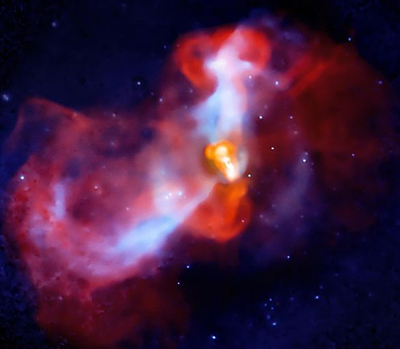
An active galaxy is a galaxy that has a very small core of extremely high powered emissions emanating from the center of the galaxy. The core is very bright and may be highly variable compared to the rest of the galaxy. Some active galaxies have jets emanating from two sides of the center. It is believed that almost all galaxies have super-massive black holes at their centers. "Active" galaxies have an Active Galactic Nucleus (AGN) and are often referred to as "AGN" galaxies. But, not all galaxies have an "active" super-massive black hole.
For example, the black hole in our Milky Way Galaxy is not active. To be active, the galaxy must have a source of gas, dust, and/or other debris that the super-massive black hole can readily consume. As a galaxy ages, its black hole eventually runs out of local consumable materials and the black hole becomes "dormant" (but not dead).
If a fresh supply of material is devoured, a dormant super-massive black hole can begin to emit high powered jets again. This happens from time to time when two galaxies collide, or a star or nebula (cloud of gas) gets pulled into the gravity domain of a super-massive black hole. There is an accretion disk around the black hole which accelerates the materials to close to light speed and some of the material is ejected out of the disk in the form of jets.
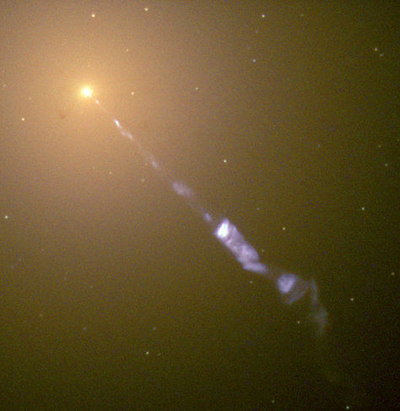
Pictured to the left above is Messier 87 (M87 for short or NGC 4486) a very active "radio" galaxy in the Virgo Cluster. The small white round circle in the center is the super-massive black hole. This image is a composite from NASA's Chandra X-ray Observatory (x-rays in blue) and the National Science Foundation's Very Large Array (VLA) radio observations in red. In this image, cold gas matter from the cluster is falling towards the core of M87, where it's met by the near light speed jet, producing shock waves in the galaxy's nearby interstellar medium.
Also to the left, is a normal light view of M87 from the Hubble Space Telescope. The super long jet is 5,000 light years in length! The yellow ball is the AGN center, whereas the long blue jet is synchrotron radiation. Synchrotron radiation originates from collisions of electrons and positrons circulating at extremely high speeds around the lines of a strong, twisting and growing magnetic field.
All AGN galaxies exhibit the same basic processes. Namely, a super-massive "active" black hole at the center and an accretion disk around the black hole. They all have a bright central core fed by local gas and/or a nearby star. They differ mainly in intensity of input. The more intense the galactic center, the higher the radiation energy it emits. The radiation emitted varies from radio and infrared waves to x-rays and gamma-rays.
Before we dive into the various sub-categories of AGNs, let us take a look at the basic structure of active galaxies. Top
Basics Of An Active Galaxy
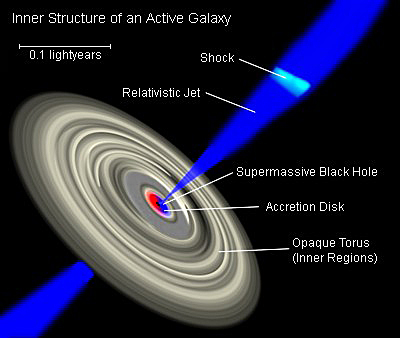
While it is still not fully understood "exactly" how jets are formed, most astro-physicists believe the jet's power comes from the accretion disc. Accretion discs around some other stellar objects are able to produce jets, but the jets around black holes are by far the most active and approach the speed of light. This is because the speed of the jet is about the same speed as the escape velocity from the accretion disk. This makes the speed of a jet from a black hole disk near the speed of light, while jets from newly born stars are much slower. When matter is ejected at speeds approaching the speed of light, these jets are called "relativistic" jets.
The most popular jet formation hypothesis is that the twisting of magnetic fields in the accretion disk collimates the outflow of plasma along the rotating axis of the black hole so that jets emerge from each face of the disk. See the artist's conception at the left.
Extremely hot matter has been observed just a few milliseconds before it plunges into the oblivion of a black hole by the European Space Agency’s (ESA's) Integral Gamma-ray Observatory. This study revealed that the high speed twisting magnetic fields form an escape tunnel at near the speed of light for some of the high energy plasma.
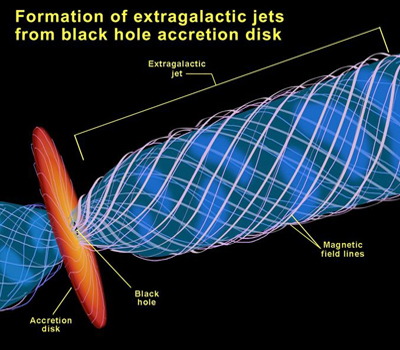
The electromagnetic radiation emitted when charged particles are accelerated "radially" is called "synchrotron" radiation. This results from electrons revolving very fast through intense magnetic fields. See the close up jet schematic at the left. Synchrotron radiation can also be produced here on earth by using bending magnets in synchrotrons, hence the name.
The radiation produced in this way has a unique characteristic polarization that can be detected by astro-physicists. The blue glow of the Crab Nebula Center to the left below is synchrotron radiation detected by the Chandra x-ray space telescope. One can see a very nice actual picture of the central black hole, the accretion disk and the jets in this fabulous image. This Crab Nebula image is 10 light years across.
Just a few hundred miles from the deadly event horizon, the space is a violent storm of hot particles and radiation. Vast amounts of particles are falling to their doom close to the speed of light raising the surrounding temperatures to millions of degrees. Ordinarily it takes just a millisecond for these particles to cross the final horizon, but astronomers now know that this chaotic region is threaded by magnetic fields that provide some particles and radiation a way out.
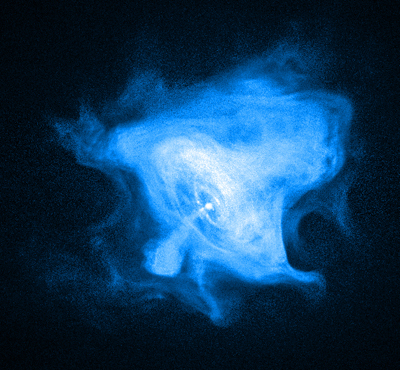
The composition of the jets is a matter of much debate in the scientific community. It is hypothesized that the jets are composed of an overall electrically neutral mixture of electrons, positrons, and protons. The evidence points to the magnetic fields being so strong as to tear away particles from the black hole’s gravitational pull and funnel them outwards. Thus, jets of matter with spiral trajectories are created that shoot hundreds of thousands of light years into outer space.
As the quality of high-energy light observations has improved over the past few years, evidence has mounted showing that photons are being created in a very hot, sparse region above and below the accretion disk. Called the corona, this violently boiling region around the comparatively cool disk is similar to the corona surrounding our sun. (The sun's corona is responsible for much of the x-ray luminosity seen in its spectrum.) Computer simulations predict that very high temperatures, plus the density and speed of the in-flowing gas, dramatically amplify the magnetic fields threading the disk, which then exert additional pressures on the incoming gas. The result is a turbulent froth orbiting the black hole at speeds approaching the speed of light.
X-rays and gamma-rays are produced as the matter swirls into the super- massive black hole. They are ejected at relativistic speeds and are also reflected from the spinning matter before its eventual accretion. All these features illustrate that astronomers are tracking matter to within twice the radius of the black hole itself, which is very, very close by astronomical standards.
Observations also reveal that the black hole is spinning extremely rapidly. It is eating matter so quickly that it verges on the theoretical limit of its ability, swallowing the equivalent of two earths per hour. Far from being a controlled process, a feeding black hole is a messy eater. "Accretion is a very messy process because of the magnetic fields that are involved", says Andrew Fabian, an astronomer at the University of Cambridge, in England. Top
AGN Black Hole Unified Theory
There are four major types of AGN (Active Galactic Nucleus) black hole galaxies whose major characteristics are as follows:
-
Radio Galaxies: radio and other wavelengths between 10 MHz and 100 GHz from synchrotron processes, but no gamma rays.
-
Seyfert Galaxies: x-rays and gamma rays up to energies of about 100,000 electron volts (eV) from thermal processes.
-
Blazar Galaxies: jets of energy exiting their black holes are pointed directly towards earth, jets rip across space at up to 99% the speed of light, jets emit very high energy gamma-rays with wavelength intensities that vary dramatically over time.
-
Quasars: most powerful, luminous, energetic objects in the universe, have a very high redshift (meaning quasars are very distant). The spectra of quasars show broad emission lines of gas excited to very high levels. They also exhibit an underlying blue continuous spectrum lacking the absorption lines from ordinary stars. Most quasars are about the same size as our Solar System (relatively small), which implies a humongous energy density, about 2 trillion times the energy of the sun. The typical brightness of a quasar is a luminosity of 10^40 watts.

The unified theory (or unified model) of active super-massive black holes was developed in the late 1970s. It was created to explain why some black holes, all similar in structure, can look completely different. Some appear to be shrouded in dust, while others are exposed and easy to see. The unified model proposes that every black hole is surrounded by a doughnut shaped large structure called a torus further outside and around the accretion disk.
Depending on how the “doughnuts” are oriented in space relative to the earth, the black holes will take on various appearances. For example, if the doughnut is positioned so that we see it edge-on, the black hole is hidden from view. If the doughnut is observed from above or below, the black hole is clearly visible. See the two sketches to the left.
Time is also a factor. The theory says that all super-massive black holes originally started out as Quasars, which are now quite scarce. Over time some run out of food, dust and small particles, and become dormant (our Milky Way black hole is an example). Or, for lack of a robust meal, they just emit less energy and become Radio and Seffert type black holes.
The unified theory says that all super-massive black holes are all of the same basic structure, we just see them from different angles and over different periods of time.
However, a recent survey of more than 170,000 supermassive black holes, published in 2014, using NASA’s Wide-field Infrared Survey Explorer (WISE), has astronomers re-examining the decades old theory about the varying appearances of these interstellar objects.
The WISE results do not completely corroborate the unified theory. The researchers found evidence that something other than a doughnut structure may, in some circumstances, determine whether a black hole is visible or hidden. The team has not yet determined what this may be, but the results suggest the unified, or doughnut, model does not have all the answers.
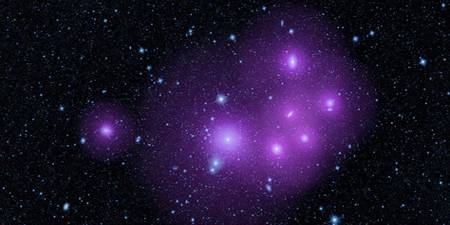
"Observations from WISE reveal that hidden black holes tend to be more clumped together than exposed ones. This violates the "unified model" which predicts we should see the same random distribution of dusty doughnuts regardless of how clumped the objects are" says NASA. "Strongly clumped galaxies are likely to have larger halos of dark matter, which might provide a clue about what else besides the doughnuts could be hiding the black holes." See the clumped galaxies in the image to the left in which dark matter is shown in purple.
“Our finding revealed a new feature about active black holes we never knew before, yet the details remain a mystery,” said Lin Yan of NASA’s Infrared Processing and Analysis Center (IPAC), based at the California Institute of Technology in Pasadena. “We hope our work will inspire future studies to better understand these fascinating objects.”
Some astronomers say the "unified model" could still be appropriate but needs adjusting to account for the unexpected observations by WISE. Top
Radio Galaxies
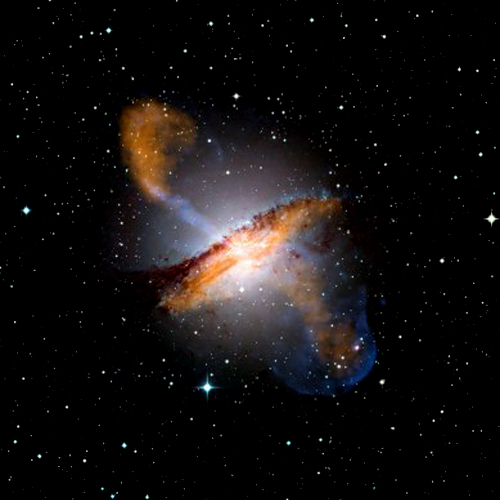
Radio galaxies are a type of AGN galaxy that are very luminous at radio wavelengths between 10 MHz and 100 GHz. The radio emission is due to the synchrotron process which is inferred from its very smooth, broad-band nature and strong polarization.
Synchrotron radiation is not confined to radio wavelengths. If the radio source can accelerate particles to high enough energies, features which are detected in the radio band may also be seen in the infrared, optical, ultraviolet and x-ray bands, but not in gamma-rays.
Shown at the left is a composite image of Centaurus A, a nearby "radio" galaxy in the constellation Centaurus. The orange "lobes" are radio emissions, which at their extremes are about one million light years from the central black hole. The blue pixels are from an x-ray image taken by the Chandra spacecraft. The stars and the accretion disk are shown in true colors from a normal light telescope. Centaurus A is the nearest galaxy to earth that contains a super-massive black hole "actively" powering a jet. The super-massive black hole has a weight of about 55 million solar masses.
Radio galaxies display a wide range of structures surrounding the black hole. The collision of black hole jets with galactic gas and dust creates shock waves that result in visible lobes. These are double, fairly symmetric, roughly elliptical structures at a fair distance on both sides of an accretion disk. (In other radio images, some lower luminosity radio sources have structures called plumes, which are much more elongated and erratic.)
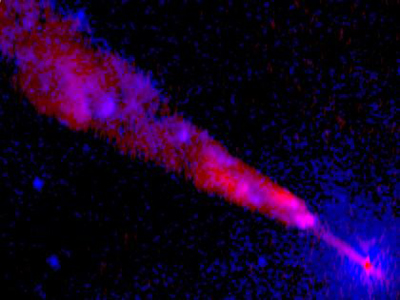
The blue and red image to the left is a close up view of the above Centaurus A jet showing the inner most 4,000 light years. This is a composite image with Chandra x-rays in blue and VLA (Very Large Array) radio observations in red. The bright purple regions show both radio waves and x-rays intermixed.
The super-massive black hole is at the lower right hand portion of the image. By taking radio observations of the jet separated by a decade of time, astro-physicists have determined that the close-in parts of the jet are moving about one half the speed of light.
Most of the X-rays from the jet are produced farther out where the jet slows down as it plows through the outer gas of the galaxy.
The x-ray structure of the jet is significantly different than the radio structure. Also, the x-ray jet is much more uneven than scientists originally expected. These results have cast some doubts on some of the more simplistic models of how high energy particles are ejected from the nucleus and travel along the jet. Top
Seyfert Galaxies
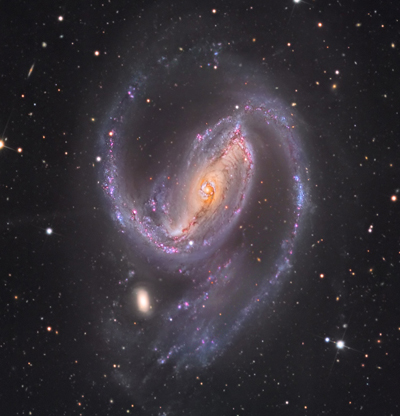
Seyfert Galaxies are a class of galaxies with nuclei that produce low energy gamma-rays. They are named after Carl Keenan Seyfert, the astronomer who first identified the class in 1943. Seyfert galaxies are characterized by extremely bright nuclei and spectra that have bright emission lines of hydrogen, helium, nitrogen, and oxygen. Like other AGN galaxies, scientists believe they have super-massive black hole centers about the size of 100 million solar masses.
The galaxy at the left is a Seyfert Galaxy, NGC 1097. Its super-massive black hole is gradually absorbing gas and other matter from around it. The distinctive ring around the black hole is bursting with new star formation due to material flowing in towards the black hole. These star forming regions are glowing extremely bright due to emissions from clouds of ionized hydrogen. The bright ring is about 5,000 light years across. The spiral arms are also full of new forming stars.
Seyfert galaxies typically emit most of their gamma rays up to energies of about 100,000 electron volts (eV) and then fade at higher energies. At these low gamma-ray energies, the emissions are normally a smooth continuation of their x-ray emissions. This indicates that the processes creating the gamma-rays are thermal processes most likely from their super-massive black holes. Seyfert galaxies also show strong emissions in the infrared and ultraviolet parts of the spectrum. Top
Blazar Galaxies
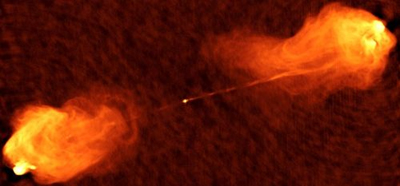
In the radio image at the left, two jets shoot out of the center of active galaxy Cygnus A with large yellow/reddish lobes on either side. When an active galaxy is oriented so that the jets of energy exiting the black hole are pointed directly towards earth, the observations become more dramatic. These objects are called blazars. But blazars are fairly rare among active nuclei, with only about 2,700 known at this time.
In a blazar, the emitted light includes very high energy gamma-rays, 100,000+ electron volts, which can be a billion times more energetic than the light we can see. The material in these jets can rip across space at 99% the speed of light. Some jets remain tightly collimated for hundreds of thousands of light years.
The light generated by a blazar has other unique properties, such as wavelength intensities that vary dramatically with time. Blazars are extremely variable at all wavelengths, changing both their spectra and total energy output. Their time scales can range from less than an hour to many years. The variability of different wavelengths and their mutual relationships is a crucial test for models attempting to explain these phenomenon and identify the jet particles.
At peak emission, observing a blazar feels a little like looking down the barrel of the most powerful gun in the universe. In some cases, the material exiting a blazar appears to be moving faster than the speed of light, but this is an illusion caused by the geometry of a source moving at high speed that is nearly but not perfectly head-on. Top
Quasars
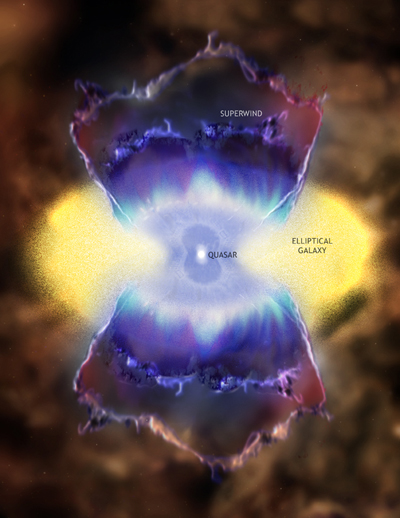
In the 1960s there were observations that there were stellar objects that emitted radio waves which were thought to be stars that had unusual optical spectra. With the optics available at the time, quasars looked like single points of light indistinguishable from faint stars. Finally it was recognized that the spectra lines had large Doppler shifts suggesting velocities that were fractions of the speed of light. These objects were obviously not ordinary stars and were named "Quasi-stellar Radio Sources", meaning "star-like radio sources", which was soon abbreviated to "quasars". At the left is a NASA artist's concept of a quasar.
AGN galaxies all have a very powerful energy source much bigger than what ordinary stars produce (including supernovas and neutron stars) coming from a small area in the center of their galaxies. These quasars are now recognized as super massive black holes at the center of emerging galaxies back in the early universe.
The quasar is believed to be powered by the accretion disc around the centralized black hole. Note that the quasar's radiation comes from the edge of the accretion disc, rather than from the accretion disk's center, which is also the center of the black hole.
Most quasar radiation exceeds the luminous output of average size galaxies. However, they appear star-like in ordinary telescopic photographs because the light from their nucleus dominates the light from the surrounding galaxy. Quasars are the most luminous, powerful, and energetic objects in the universe.
They inhabit the centers of active very young galaxies and emit up to a thousand times the energy output of our whole Milky Way and two trillion times the energy of our sun. Most quasars have a very high "redshift" (the measurement of the stretching of light to the red end of the spectrum by the expansion of the universe).
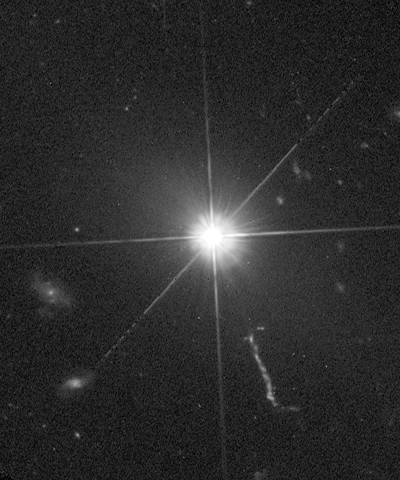
The implication of the large redshift is that quasars are very distant, meaning they are objects from much earlier in the universe's history. Most were born when the universe was less than 5 billion years old, at a redshift of 1.0 or more.
Quasars are about the same size as our Solar System (i.e. relatively small). This implies a humongous energy density. To create a luminosity of 10^40 watts, the typical brightness of a quasar, a super-massive black hole would have to consume the material equivalent of 10 stars per year.
The brightest known quasars devour 1,000 solar masses every year. Shown at the left and also the jet directly below is the first (and brightest) quasar visible from earth - 3c273. Galaxy 3c273 is located in the Orion Constellation, but is about 2.4 billion light years away (redshift = 0.158), actually quite close by celestial standards.
Since light cannot escape the super massive black holes that are at the center of quasars, the escaping light is actually generated outside the event horizon of the black hole by extreme twisting magnetic forces and the immense friction of incoming material.
Most of the material falling into the central black hole's gravity field is unlikely to fall directly into the black hole, but rather into the accretion disk surrounding the black hole. The falling matter will have some angular momentum of its own that will add to the angular momentum of the accretion disc so that total angular momentum is conserved.
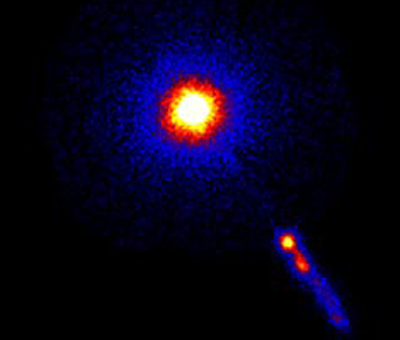
Several dozen nearby large galaxies have been shown to contain a central black hole in their nuclei with no sign of a quasar nucleus. It is thought that all large galaxies have a super-massive black hole at their center, but only a small fraction emit powerful radiation and are seen as quasars.
Many scientists contend that most supermassive black holes today were once quasars in the early universe. As the quasars fuel was depleted they become the supermassive black holes that we observe today. Some become almost dormant for lack of fuel, for example: the black hole in the center of the Milky Way. Scientists believe quasars may be re-ignited from dormant galaxies if they ingest a fresh source of gas or other matter.
The spectra of quasars are quite different from those of ordinary galaxies showing broad emission lines of gas excited to high levels. They also exhibit a blue continuous spectrum lacking the absorption lines from ordinary stars. The beams of radiation from material moving close to the speed of light indicates that the jet's light has been boosted such that it overwhelms everything else.
The quasar's luminosity is variable at nearly every wavelength from radio waves to gamma-rays on time scales of a few days to decades. Also, the variability in light output indicates that most of the radiation is coming from tiny regions, no more than a few light hours in size. Top
Quasars Are Dying
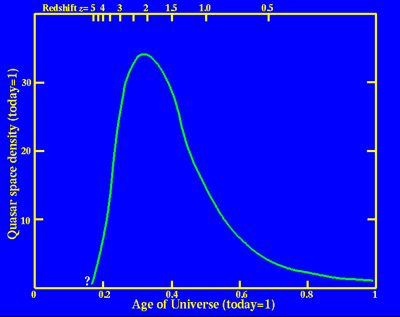
The diagram at the left was published by Bill Keel, Professor Of Physics and Astronomy at the University Of Alabama. The scale on the bottom of the chart is time, but it can also be redshift as shown at the top of the chart. Looking at very distant objects in the universe is equivalent to looking back in time because of the constant speed of light in a vacuum. The number of quasars peaks at a redshift of about 2.25, when the universe was about 3 billion years old.
The oldest quasar from the Sloan Digital Sky Survey (SDSS) is one with a redshift of 6.4 which was about 800,000 years after the Big Bang. At a redshift of about 4.0 there was a rapid increase of quasars. About this time early galaxies formed, collected enough material to make a fairly massive black hole, and had enough massive stars in its immediate neighborhood to devour and produce the heavy elements seen in quasar spectra.
The first stars, forming from pure hydrogen and helium, were quite different from the ones we see today. The first stars were very massive and hot, exploding with more violence than today's supernovae. These stars, with masses hundreds of times larger than our sun, would have scattered their make up of heavier elements very widely as each exploded. These explosions would have destroyed the surrounding gas clouds and forced galaxy formation to start over.
The great abundance of quasars in the early universe is consistent with the notion that a quasar shuts off when its black hole engine has consumed the fuel surrounding the host galaxy. In the early universe there most likely was more mass (mostly gas) accessible to black holes than today because much of it has already been consumed. As the hungry black holes of the early quasars ran out of local fuel, they eventually shut down. Today there are vast voids between galaxies and little food for the massive black holes. This has caused most of the quasars to be dormant for some time. To see a lot of burning quasars, we have to look a considerable way back in time. Top
Quasars Used For Research
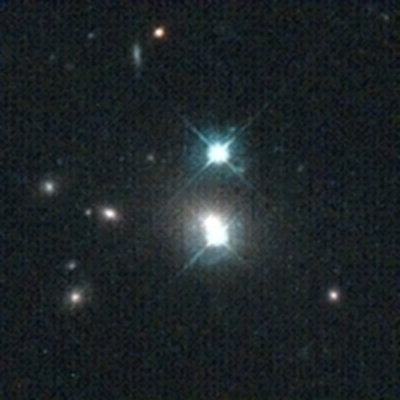
Quasars, the brightest objects in the universe, can be used as research tools to study objects in the distant universe through gravitational lensing and other techniques. One of the successes of Einstein's general theory of relativity was the prediction of the "bending of light" by a massive object (such as the sun). See the Gravitational Lensing section. The light from a distant quasar can also find itself bent by the curvature of space-time when passing around massive objects such as galaxies or clusters of galaxies.
Mass that bends quasar light can be normal mass or dark matter (a better name would be transparent matter). A significant "proof" of dark matter comes from carefully plotting the way that light from distant images, such as quasars, is distorted by galaxies. Using this technique, it is possible to quite accurately map where dark matter is located and to estimate its mass.
The photo to the left shows two images of a distant quasar (0957+561 in Ursa Major) also from a paper by Bill Keel. Only the top image is a real quasar. The bottom one is formed by gravitational lensing and is a false image. Astronomers can tell that both images are from the same quasar because both have identical spectra. Q0957, discovered in 1979, was the first quasar observed to have gravitational lensing. So far there have been about 50 more quasars discovered that exhibit gravitational lensing.
Analysis of quasar data can tell us how large the force of dark energy might be and measure the Hubble constant independent of traditional techniques. Using the light from 50,000 quasars and a new technique called "baryon acoustic oscillations" (BAO), cosmologists have been able to measure the early deceleration and recent acceleration of the universe. See the BOSS Project as part of the SDSS Program. Top
Most Distant Quasar Discovered
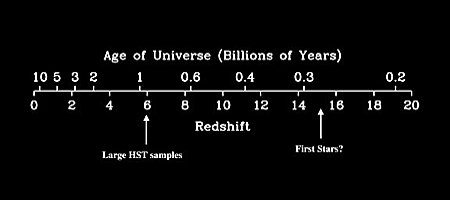
A huge black hole, the size of 800 million suns, is the the most-distant supermassive black hole ever observed. Its discovery was published in December, 2017. The formal name of the quasar is ULAS J1342+0928 and it is located in the Boötes constellation. It took 13.1 billion years for the light from the quasar to reach the earth. The light they observed was formed only about 690 million years after the Big Bang. The newly discovered quasar has a redshift of 7.54 (see the Age Chart to the left), based on the ionized carbon emissions from the galaxy that hosts the black hole. Before now, only one other quasar was known to exist at a redshift greater than 7.0 despite extensive searching.
This quasar comes from a time known as "the Epoch of Reionization" which occured after the universe emerged from the Dark Ages. The light from ULAS J1342+0928 was emitted before the end of the transition of the early medium from an "electrically neutral state" to an "ionized state", which ended about one billion years after the Big Bang. During this period both huge quasar black holes and early galaxies were forming. It raises the question of just "how" early black holes formed. (See the next section below.)
The team noted that they had found the quasar using data from the Wide-field Infrared Survey Explorer (WISE) in space, combined with ground-based surveys from one of the Magellan Telescopes at the Las Campanas Observatory in Chile, plus the Large Binocular Telescope in Arizona, and also the Gemini North telescope in Hawaii. That is: one outer space observatory and three telescopes on earth were involved.
Largest And Brightest Quasars Discovered
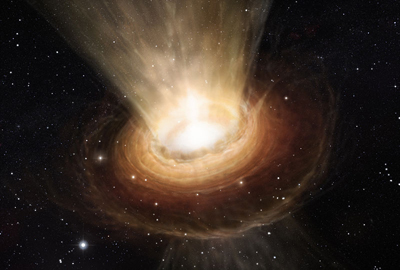
The discovery of monster quasar, SDSS J0100+2802, is an important step in understanding how quasars, the most powerful objects in the universe, had evolved. An international team led by astronomers from the University of Arizona and from Peking University in China announced their findings in February, 2015. With a luminosity of 420 trillion suns, quasar SDSS J0100+2802 is the "brightest" quasar ever discovered. See the artist's conception of this quasar to the left.
This huge quasar has a central black hole mass of "12 billion" solar masses! It is the second most massive black hole in the universe that has been confirmed by NASA's NuSTAR (Nuclear Spectroscopic Telescope Array), an x-ray space telescope designed specifically to study black holes. In early 2015 black hole OJ 287 had been confirmed at 18 billion solar masses.
The SDSS J0100+2802 quasar was found after astronomers selected the quasar from the Sloan Digital Sky Survey (SDSS) of over 500 million objects in the northern skies because of its distinctive red color. They then followed up with three other telescopes to study the object in detail. It has a redshift of 6.30, making it a very old and distant object about 13.0 billion light-years from earth. Despite their high luminosity, distant quasars are are very difficult to find and are extremely faint to our scientific eyes because of their great distance in a dusty universe. Only 40 known quasars have a redshift higher than 6.0, the yardstick that defines the boundary of the early universe.
The Formation Of Huge Early Black Holes. Astronomers have been taxed to explain how the above enormous black holes could have formed so early in cosmic history - so very soon after the first stars and galaxies emerged. A quasar is an extremely bright cloud of mostly gas in the process of being pulled into a huge black hole. As the material accelerates towards the black hole it heats up, emitting an extraordinary amount of x-ray and gamma energy which then pushes away other material falling behind it. This process, known as radiation pressure, is believed to limit the growth "rate" of black holes. However, the above black holes gained enormous mass in an extremely short period of time, which differs from the current theory of black hole growth. Discoveries such as SDSS J0100+2802 and ULAS J1342+0928 (above) push astronomers in favor of the "direct-collapse black hole" (DCBH) formation scenario. DCBH theory predicts that huge pristine gas nebulas collapse on their own to form black holes directly. Thus the ultra-luminous quasar, SDSS J0100+2802, provides a unique laboratory to study black hole formation in the early universe. Top
Quasars Align Across Billions Of Light Years
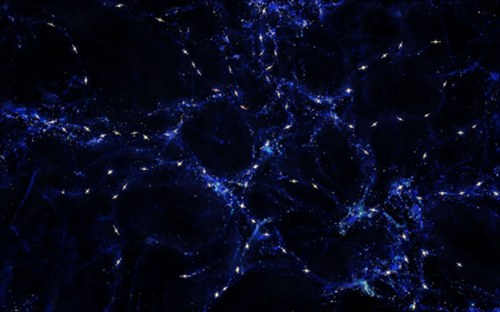
A team from the University of Liège in Belgium used the VLT (Very Large Telescope in Chile) to study 93 quasars spread over billions of light-years when the universe was about one third of its current age. The data revealed quasar alignments over the largest structures in the universe. This study was published by ESO (the European Southern Observatory) in November, 2014.
When astronomers look at the distribution of galaxies on scales of billions of light-years, they find that they are not evenly distributed. The galaxies form a cosmic web of filaments and clumps around huge voids where galaxies are scarce.
An artist's impression (to the left) shows schematically the mysterious alignments of the spin axes of quasars and the large scale structures that they inhabit. The large scale structure is shown in blue and quasars are marked in white with the rotation axes of their black holes indicated with a line. (This picture is for illustration only and does not depict the real distribution of galaxies and quasars.)
The new VLT results indicate that some of the quasars' rotational axes are aligned with each other, despite the fact that these quasars are separated by billions of light years. They also tend to be parallel to the large scale structures in which they find themselves. So, if the quasars are in a long filament, then the spins of the central black holes will align with the long filament. Researchers estimate that the probability of these unique alignments are simply the result of chance is less than 1%.
The team could not see the rotation axes or the jets of the quasars directly. Instead they measured the polarization of the light from each quasar and found a significantly polarized signal. The direction of this polarization, combined with other information, could be used to deduce the angle of the accretion disc and hence the direction of the spin axis of the quasar.
A correlation between the orientation of quasars and the structure they belong to is an important prediction of current computer models of the formation of the universe. This data provides the first "observational confirmation" of this correlation on scales much larger than had been expected.